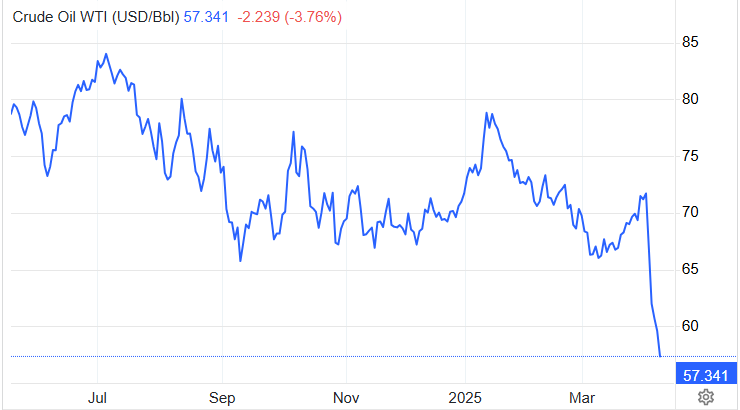Crude oil prices are significant to the global economy because oil is an important resource for transportation, industry, and energy. When the prices of oil change, it has wide-reaching impacts increasing the cost of goods and services and affecting the financial stability of entire countries. The price of crude oil can fluctuate due to various factors, such as changes in supply, and demand, geopolitical events, technological advancements, and environmental regulations. These price shifts can have a profound impact on national economies, energy security, and even global political stability.

Crude Oil Chart
In recent months, global oil price have experienced significant decline, causing changes across various industries and economies. Oil is critical commodity that fuels majority of world’s energy requirement and falling in oil price has been attributed from dynamics changes in demand and supply. Meanwhile lower oil price can provide relief at consumer level and also present challenge for oil producing nations and energy markets worldwide.
What are the Factors behind Decline?
The trade tensions and tariffs concerns significantly impact the price of oil after 104% of tariffs imposed by the U.S. on Chinese goods which led to a response from China imposing 34% tariffs on U.S. exports. This escalation will lead to a trade war, with both sides taking measures that adversely affect global economic growth. It affects oil prices because oil demand is closely linked to the global economy. A slowdown in economic activity, especially in large economies like the U.S. and China reduces industrial and transportation demand for oil. Because if economic growth slows down, companies produce less, consumers buy fewer goods, and demand for oil & energy declines. Recent reports show Brent crude prices fell nearly 4%, hitting their lowest levels since 2021 due to tariff escalation in global trade.
The OPEC+ which is a group of oil-producing countries including the Organisation of the Petroleum Exporting Countries (OPEC) and non-member countries like Russia, has cut oil production in the past in order to stabilize or raise oil prices. However, they now agreed to increase the output of oil by 2.2 million barrels per day (bpd) for the next 18 months. When the supply of oil in the global market is high it leads to a fall in price because the oil market operates on a delicate balance between demand and supply. By increasing supply in the current scenario where a tariff war is going on between countries, OPEC+ risks the oversaturation of the market, especially when global demand is not rising at the same pace. The planned output increase is one of the key reasons for the fall in oil prices recently.
China is one of the largest consumers of oil and energy and demand growth concern in China is significantly affecting oil prices. China state-owned refiner Sinopec has stated that oil price consumption in the country could stagnant and start declining in upcoming years. This is particularly happening due to the shift away from diesel and Gasoline and moving towards more electric vehicles (EVs) and other energy efficiency measures. Along with its current tariffs implications by U.S. is also manipulating the oil prices globally because China is the largest manufacturing hub for goods which is the majority export to the U.S. but after tariffs, it will affect production in China. The demand in China is a critical factor in the global oil market. If China decreases its oil consumption, the global demand for oil falls which impacts oil prices. This situation is getting worse by the fact that other countries have not fully replaced China in oil consumption. The uncertainty around future demand in China and the shift towards renewable energy raises concerns about the long-term viability of high oil prices.
The other factor contributing to falling oil prices is the strengthening of the U.S. dollar. The value of the U.S. dollar has increased recently due to hold interest rate decision by the Federal Reserve which is relatively high compared to other countries. It means a stronger dollar takes more than other currencies to purchase a barrel of oil. The oil is priced globally in U.S. dollars. That’s why when the dollar is stronger it takes more of other currencies to purchase a barrel of oil. It also impacts the demand for oil from countries, as higher costs and weak demand discourage imports. A stronger rising dollar and no rate cut by the Fed are also contributing to weak global oil demand.
Future Outlook of Crude Oil
The crude oil fell to four-year lows this week because rising geopolitical tensions and tariff-driven demand concerns overshadowed supply fundamentals. The six-month spread of Brent collapsed 86% from January highs signaling a falling surplus. WTI and Brent both have fallen for five consecutive sessions because of global trade disruptions raised concern of slow economic activity and energy consumption. Along with it OPEC+ decision to boost May’s output by 411,000bpd has provoked a bearish tone.
WTI crude is hanging around $57.11, mainly in correction mode after breaking major support levels. It has decreased a lot recently, breaking important support levels, and is currently now in the correction phase. Currently, resistance is at $58.5 and if the price goes back up and breaks above the $58.5 mark, it could start moving up. The support price of crude at $56.57 is the next price where buyers may enter and if the price falls below this level it could fall to $54.18. In short, the price is currently under pressure and it could keep falling until it breaks above $58.45 and if it drops below $56.57, it may fall to $54.18. Although there is a chance for a small bounce back because the market is oversold but majorly trend is negative.
Brent crude is currently around at $60.54 which is below its pivot point level of $61.42. It means the price has dropped and is continuously falling. The next support levels to watch for the drop are $59.51 and $57.09 after failing to stay above $64.12. The resistance level to watch is $61.42 and if it breaks that it may rise to $64.12 and $65.59. There is a chance for a small bounce back but the overall trend is still bearish. We expect global oil markets will remain relatively tight until the middle of 2025 and could fall further in the last of 2025 because OPEC+ countries are likely to cut their production but countries other than OPEC+ will increase output.

















